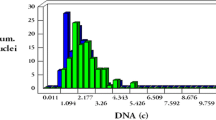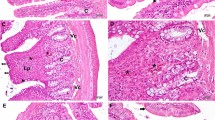Abstract
The present study was designed to evaluate the possible protective effects of 3,3′-diselenodipropionic acid (DSePA), a potent radioprotector, against oxidative organ damage induced by whole body γ-irradiation and explore its mechanistic effects. The mice were subjected to whole body γ-irradiation at 5 Gy for the detection of oxidative stress, apoptosis, and proliferation in the intestinal (jejunum) tissue and at 7 Gy for the examination of intestinal inflammation and immune imbalance. Groups of mice received intraperitoneal injections of DSePA (2 mg/kg/day) or vehicle (phosphate-buffered saline) for 5 consecutive days prior to irradiation. The whole body γ-irradiation of mice led to the induction of oxidative stress and apoptosis in the intestinal tissue, and pretreatment with DSePA significantly reduced both these parameters. It was also found to abrogate the radiation-induced intestinal inflammatory response and augment the proliferation of intestinal cells. Additionally, irradiation-induced polarization of Th1/Th2 immune balance toward the Th2-dominant direction and pretreatment with DSePA ameliorated this shift, which may be beneficial for the recovery from radiation injury. In conclusion, pretreatment with DSePA prevented radiation-induced oxidative damage in small intestine and the underlying mechanisms responsible for this could be attributed to inhibition of oxidative stress, apoptosis, and inflammation.







Similar content being viewed by others
References
Andreassen CN, Grau C, Lindegaard JC (2008) Chemical radioprotection: a critical review of amifostine as a cytoprotector in radiotherapy. Semin Radiat Oncol 13:62–72
Bass H, Mosmann T, Strober S (1989) Evidence for mouse Th1- and Th2-like helper T cells in vivo: selective reduction of Th1-like cells after total lymphoid irradiation. J Exp Med 170:1495–1511
Bismar MM, Sinicrope FA (2002) Radiation enteritis. Curr Gastroenterol Rep 4:361–365
Buell MG, Harding RK (1989) Proinflammatory effects of local abdominal irradiation on rat gastrointestinal tract. Dig Dis Sci 345:390–399
Burdelya LG, Krivokrysenko VI, Tallant TC, Storm E, Gleiberman AS, Gupta D, Kurnasov OV, Fort FL, Osterman AL, DiDonato JA, Feinstein E, Gudkov AV (2008) An agonist of toll-like receptor 5 has radioprotective activity in mouse and primate models. Science 320:226–230
Carr KE, Hume SP, Ettarh RR, Carr EA, McCollough JS (1995) Radiation-induced changes to epithelial and non-epithelial tissue. In: Dubois A, King GL, Livengood DR (eds) Radiation and the gastrointestinal tract. CRC Press, Boca Raton, pp 113–128
Carsten AL (1984) Acute lethality: the hematopoietic syndrome in different species. In: Broerse JJ, MacVittie TJ (eds) Response of different species to total body irradiation. Martinus Nijhoa, Boston, pp 59–86
Degregori J (2002) The genetics of the E2F family of transcription factors: shared functions and unique roles. Biochim Biophys Acta 1602:131–150
Denham JW, Hauer-Jensen M (2002) The radiotherapeutic injury-a complex “wound”. Radiother Oncol 63:129–145
Fornace AJ Jr, Nebert DW, Hollander MC, Luethy JD, Papathanasiou M, Fargnoli J, Holbrook NJ (1991) Induction by ionizing radiation of the gadd45 gene in cultured human cells: lack of mediation by protein kinase C. Mol Cell Biol 11:1009–1016
Freeman SL, MacNaughton WK (2000) Ionizing radiation induces iNOS-mediated epithelial dysfunction in the absence of an inflammatory response. Am J Physiol 275:G1353–G1360
Freeman SL, Hossain M, MacNaughton WK (2001) Radiation-induced acute intestinal inflammation differs following total-body versus abdominopelvic irradiation in the ferret. Int J Radiat Biol 77:389–395
Haton C, Francois A, Vandamme M, Wysocki J, Griffiths NM, Benderitter M (2007) Imbalance of the antioxidant network of mouse small intestinal mucosa after radiation exposure. Radiat Res 167:445–453
Haydont V, Marie-Catherine V-B (2007) Maintenance of radiation-induced intestinal fibrosis: cellular and molecular features. World J Gastroenterol 13:2675–2683
Hissin PJ, Hilf R (1976) A fluorometric method for determination of oxidized and reduced glutathione in tissues. Anal Biochem 74:214–226
Kim SH, Lee HJ, Kim JS, Moon C, Kim JC (2009) Protective effect of an herbal preparation (HemoHIM) on radiation-induced intestinal injury in mice. J Med Food 12:1353–1358
Koenig S, Krause P, Schmidt T-K, Rave-Fraenk M, Rothe H, Hermann RM, Becker H, Hess CF, Christiansen H (2008) Irradiation as preparative regimen for hepatocyte transplantation causes prolonged cell cycle block. Int J Radiat Biol 84:285–298
Kumar BS, Kunwar A, Ahmad A, Kumbhare LB, Jain VK, Priyadarsini KI (2009) In vitro radioprotection studies of organoselenium compounds: Differences between mono and diselenides. Radiat Environ Biophys 48:379–384
Kunwar A, Mishra B, Barik A, Kumbhare LB, Pandey R, Jain VK, Priyadarsini KI (2007) 3,3′-Diselenodipropionic acid, an efficient peroxyl radical scavenger and a GPx mimic, protects erythrocytes (RBCs) from AAPH-induced hemolysis. Chem Res Toxicol 20:1482–1487
Kunwar A, Bansal P, Kumar SJ, Bag PP, Paul P, Reddy ND, Kumbhare LB, Jain VK, Chaubey RC, Unnikrishnan MK, Priyadarsini KI (2010) In vivo radioprotection studies of 3,3′-diselenodipropionic acid, a selenocystine derivative. Free Radic Biol Med 48:399–410
Medina VA, Croci M, Mohamad NA, Massari N, Garbarino G, Cricco GP, Nunez MA, Martin GA, Crescenti EJV, Bergoc RM, Rivera ES (2007) Mechanisms underlying the radioprotective effect of histamine on small intestine. Int J Radiat Biol 83:653–663
Mehata S, Mehata L, Mongia SP (1975) Effect of whole body X-irradiation on liver of Swiss albino mice. Int J Exp Biol 13:73–75
Mishra B, Barik A, Kunwar A, Kumbhare LB, Priyadarsini KI, Jain VK (2008a) Correlating the GPx activity of selenocystine derivatives with one-electron redox reactions. Phosphorus Sulfur Silicon 183:1018–1025
Mishra B, Kumbhare LB, Jain VK, Priyadarsini KI (2008b) Pulse radiolysis studies on reactions of hydroxyl radicals with selenocystine derivatives. J Phys Chem B 112:4441–4446
Molla M, Panes J (2007) Radiation-induced intestinal inflammation. World J Gastroenterol 13:3043–3046
Molla M, Gironella M, Salas A, Miquel R, Perez-del-Pulgar S, Conill C, Engel P, Biete A, Pique JM, Panes J (2001) Role of P-selectin in radiation-induced intestinal inflammatory damage. Int J Cancer (Radiat Oncol Invest) 96:99–109
Molla M, Gironella M, Miquel R, Tovar V, Engel P, Biete A, Pique JM, Panes J (2003) Relative roles of ICAM-1 and VCAM-1 in the pathogenesis of experimental radiation-induced intestinal inflammation. Int J Radiat Oncol Biol Phys 57:264–273
Monti P, Wysocki J, Van Der Meeren A, Griffiths NM (2005) The contribution of radiation-induced injury to the gastrointestinal tract in the development of multi-organ dysfunction syndrome or failure. Br J Radiol S27:89–94
Morgan WF (2003) Non-targeted and delayed effects of exposure to ionizing radiation: II. Radiation-induced genomic instability and bystander effects in vivo, clastogenic factors and transgenerational effects. Radiat Res 159:581–596
Ong ZY, Gibson RJ, Bowen JM, Stringer AM, Darby JM, Logan RM, Yeoh ASJ, Keefe DM (2010) Pro-inflammatory cytokines play a key role in the development of radiotherapy-induced gastrointestinal mucositis. Radiat Oncol 5:22
Panes J, Anderson DC, Miyasaka M, Granger DN (1995) Role of leukocyte-endothelial cell adhesion in radiation-induced microvascular dysfunction in rats. Gastroenterology 108:1761–1769
Paris F, Fuks Z, Kang A, Capodieci P, Juan G, Ehleiter D, Haimovitz-Friedman A, Cordon-Cardo C, Kolesnick R (2001) Endothelial apoptosis as the primary lesion initiating intestinal radiation damage in mice. Science 293:293–297
Park E-M, Park J-S, Kim Y-J, Sung J-S, Hwang T-S, Kim W-C, Han M-Y, Park Y-M (2001) Role of oxidative stress in the radiation-induced lung pathogenesis in mice. J Biochem Mol Biol 34:544–550
Park H, Jo S, Paik S (2005) Factors effecting the Th2-like immune response after gamma-irradiation: low production of IL-12 heterodimer in antigen-presenting cells and small expression of the IL-12 receptor in T cells. Int J Radiat Biol 81:221–231
Potten CS (1990) A comprehensive study of the radiobiological response of the murine (BDF1) small intestine. Int J Radiat Biol 58:925–973
Quarmby S, Kumar P, Kumar S (1999) Radiation-induced normal tissue injury: role of adhesion molecules in leukocyte-endothelial cell interactions. Int J Cancer 82:385–395
Riehl TE, Newberry RD, Lorenz RG, Stenson WF (2004) TNFR1 mediates the radioprotective effects of lipopolysaccharide in the mouse intestine. Am J Physiol Gastrointest Liver Physiol 286:G166–G173
Riley PA (1994) Free radicals in biology: oxidative stress and the effects of ionizing radiation. Int J Radiat Biol 65:27–33
Ruth N (1997) Modulation with cytokines of radiation injury: suggested mechanisms of action. Environ Health Perspect 105:1463–1465
Seno H, Sawada M, Fukuzawa H, Morita-Fujisawa Y, Takaishi S, Hiai H, Chiba T (2002) Involvement of tumor necrosis factor alpha in intestinal epithelial cell proliferation following paneth cell destruction. Scand J Gastroenterol 37:154–160
Tak JK, Park JW (2009) The use of ebselen for radioprotection in cultured cells and mice. Free Radic Biol Med 46:1177–1185
Van der Meeren A, Monti P, Vandamme M, Squiban C, Wysocki J, Griffiths N (2005) Abdominal radiation exposure elicits inflammatory responses and abscopal effects in the lungs of mice. Radiat Res 163:144–152
Vigneulle RM, Rao S, Fasano A, MacVittie TJ (2002) Structural and functional alterations of the gastrointestinal tract following radiation-induced injury in the rhesus monkey. Dig Dis Sci 47:1480–1491
Wang J, Zhemg H, Kulkarni A, Ou X, Hauer-Jensen M (2006) Regulation of early and delayed radiation responses in rat small intestine by capsaicin-sensitive nerves. Int J Radiat Oncol Biol Phys 64:1528–1536
Weiss JF, Simic MG (1988) Perspectives in radioprotection. Pharmacol Ther 39:1–414
Weiss JF, Kumar KS, Walden TL, Neta R, Landauer MR, Clark EP (1990) Advances in radioprotection through the use of combined agent regimens. Int J Radiat Biol 57:709–722
Weiss JF, Srinivasan V, Kumar KS, Landauer MR (1992) Radioprotection by metals: selenium. Adv Space Res 12:23–231
Weiss JF, Srinivasan V, Kumar KS, Landauer MR, Patchen ML (1994) Radioprotection by selenium compounds. In: Favier AE, Neve J, Fauve P (ed) Trace elements and free radicals in oxidative diseases. AOCS Press, pp 211–222
Weiss JF, Landauer MR, Gunter-Smith PJ, Hanson WR (1995) Effect of radioprotective agents on survival after acute intestinal radiation injury. In: Dubois A, King GL, Livengood DR (eds) Radiation and the gastrointestinal tract. CRC Press, Boca Raton, pp 183–199
Weiss JF, Landauer MR, Hogan JB, Gunter-Smith PJ, Benson KA, Neta R, Hanson WR (1997) Modification of radiation-induced gastrointestinal and hematopoietic injury in mice by combinations of agents: effects of indomethacin and caffeine. Adv Exp Med Biol 400B:865–872
Wu C-T, Chen W-C, Lin P-Y, Liao S-K, Chen M-F (2009) Androgen deprivation modulates the inflammatory response induced by irradiation. BMC Cancer 9:92
Xiong Y, Hannon GJ, Zhang H, Casso D, Kobayashi R, Beach D (1993) p21 is a universal inhibitor of cyclin kinases. Nature 366:701–714
Acknowledgments
The authors wish to thank Mr. L.B. Kumbhare, Chemistry Division, for synthesizing 3,3′-diselenodipropionic acid. The authors are also grateful to Drs. S.K. Sarkar, Head, RPC Division, T. Mukherjee, Director, Chemistry Group and K.B. Sainis, Director, Bio-Medical Group, BARC for encouragement. Support from Board of Research in Nuclear Sciences (BRNS) for the research grant under prospective research fund scheme (Grant No.—BRNS/2007/38/5) is acknowledged.
Conflict of interest
None.
Author information
Authors and Affiliations
Corresponding author
Additional information
An erratum to this article can be found at http://dx.doi.org/10.1007/s00204-011-0699-9
Rights and permissions
About this article
Cite this article
Kunwar, A., Bag, P.P., Chattopadhyay, S. et al. Anti-apoptotic, anti-inflammatory, and immunomodulatory activities of 3,3′-diselenodipropionic acid in mice exposed to whole body γ-radiation. Arch Toxicol 85, 1395–1405 (2011). https://doi.org/10.1007/s00204-011-0687-0
Received:
Accepted:
Published:
Issue Date:
DOI: https://doi.org/10.1007/s00204-011-0687-0




